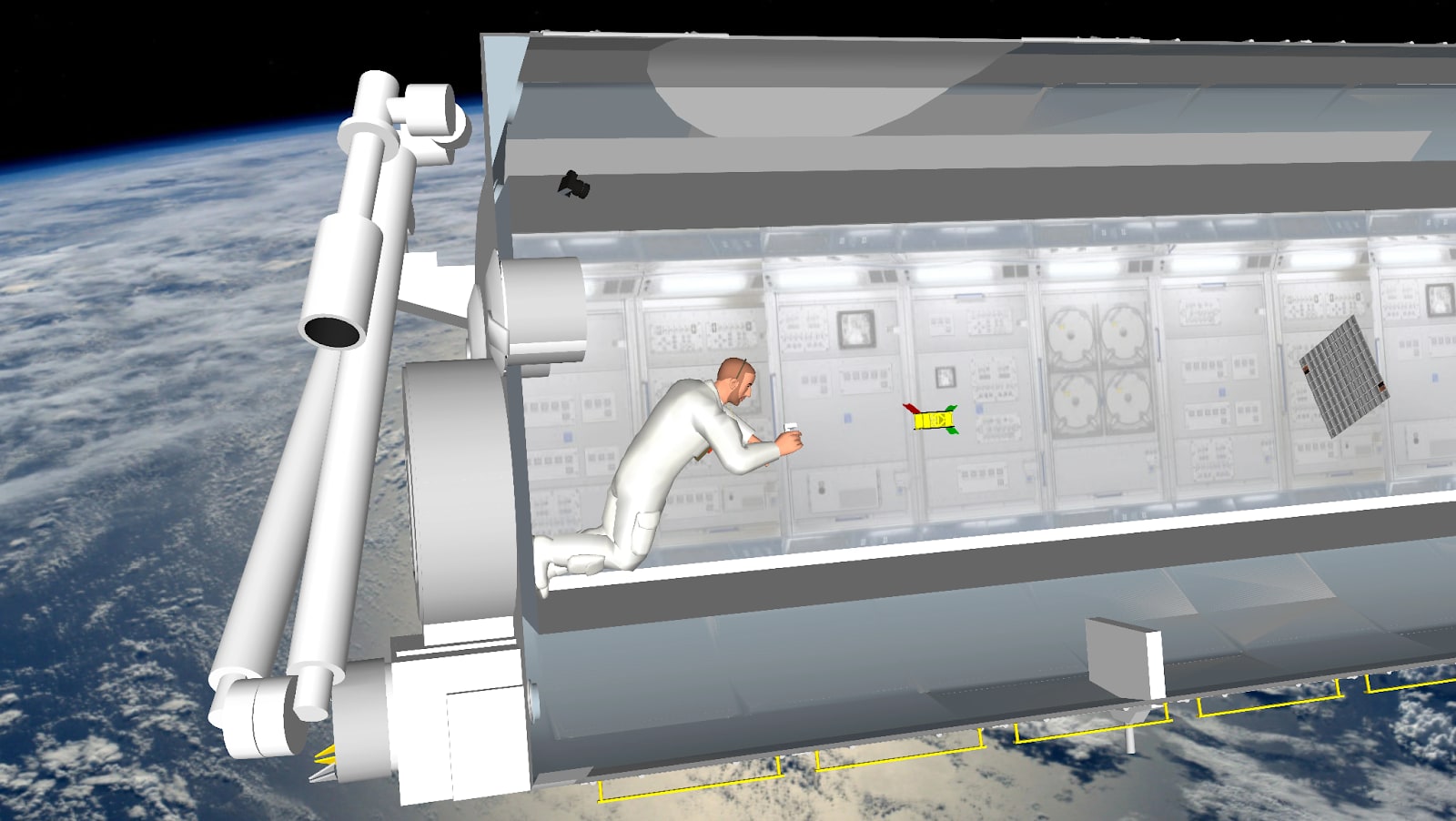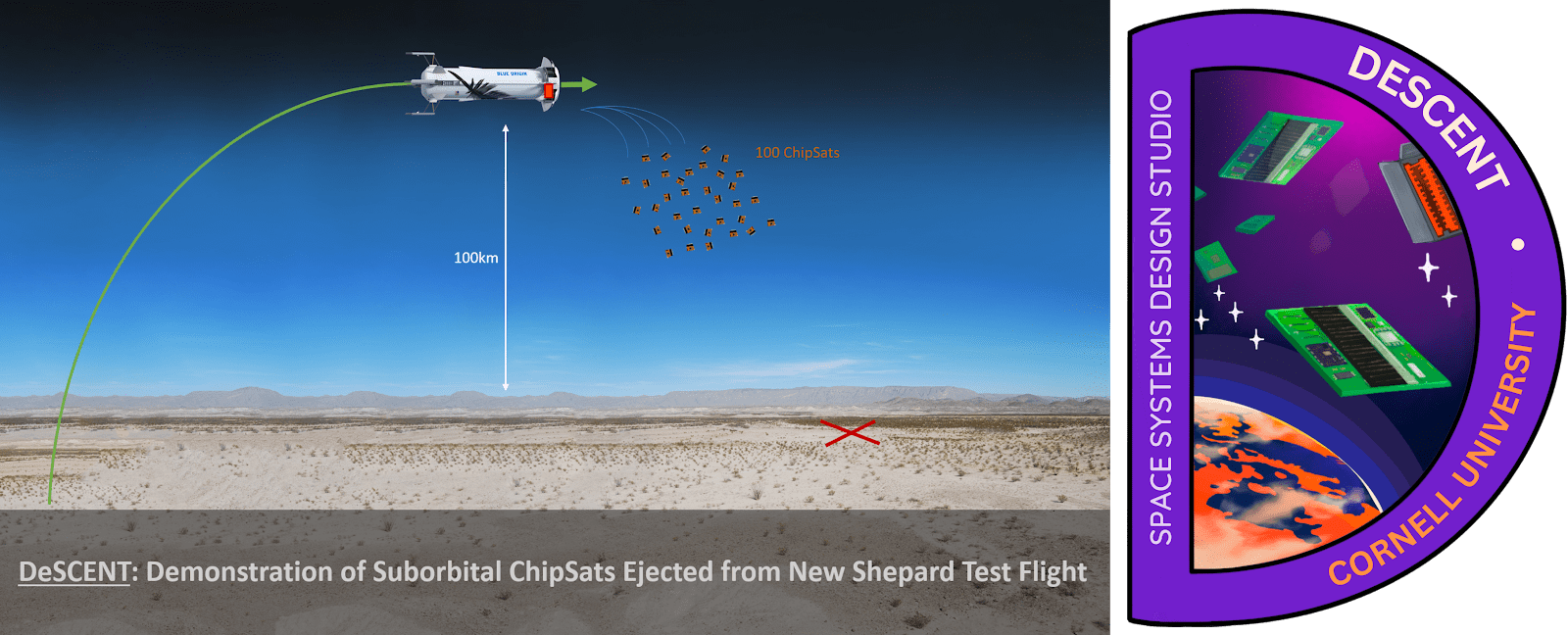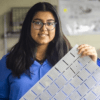This project is now in update mode. Check back regularly to see how things are progressing.
Let's build this spacecraft together!
Our story
Students at the Space Systems Design Studio are building light sail-carrying, cube-shaped satellites—a stepping stone to our nearest star system. With the first-ever holographic images in space, tiny ChipSat computers, and low-cost components, these early technology demonstrations open up new techniques for interstellar messages and affordable spacecraft.
Our story brings together NASA scientists, holographic artists, Silicon Valley inventor-mentors, and, of course, Cornell students. Our team has been working tirelessly to create science fact from science fiction and both of our missions are finally making it up to orbit this year! Your donation helps us fly spacecraft years in the making!
 Alpha CubeSat mission artwork.
Alpha CubeSat mission artwork.
[CAD assets courtesy of Andy Filo; render by Stephanie Young '23]
Why CubeSats? Light Sails? ChipSats?
Our mission is pioneering multiple techniques that may fundamentally change deep space exploration. Light sails are large reflective sheets that harness momentum from photons! Every small particle of light that bounces off the material provides a very small push. In the vacuum of space, these pushes are enough to speed up the craft. With enough time or a strong enough light source (laser array), light sails can travel faster and farther than any spacecraft made to date! The possibilities for light-sail driven space exploration are truly limitless.
 Comparison of Cornell's Alpha light sail to notable sail designs
Comparison of Cornell's Alpha light sail to notable sail designs
[courtesy of Andy Filo]
Compared to other sails that have flown to date, Cornell's is significantly smaller! The one flying on our current missions is less than a meter wide. Despite this, it can fly just as fast! Our sail has an outstanding surface area to mass ratio, thanks to the use of gram-scale spacecraft (ChipSats) that fit within the palm of your hand! These tiny spacecraft contain all the essential functionality of their larger counterparts. They will send us data on the sail's orientation and location while in space, and on future missions, shall even steer the sail towards exciting destinations!

The payload: an origami-folding retroreflective light sail with four "ChipSats" for tracking and data downlink (and one day much more!) [CAD image courtesy of Andy Filo]
Sending our ChipSats and light sails to space can be challenging due to their unique shapes and size. To facilitate this, we take advantage of a standard form factor for launching small spacecraft: the CubeSat! With ever-growing popularity, CubeSats have enabled access to space for educational institutions around the world. As long as we comply with the standard set of CubeSat requirements (size, weight, safety inhibits, etc.), we can fly to space in a stack with other cubes and get shot into orbit via a spring-loaded deployer!

Exploded view of our CubeSat CAD for the Alpha mission [Courtesy of Richard Zheng '25, Adiba Sajed '24, and many more!]
Through an origami folding technique (miura fold) our light sail can stow inside the CubeSat—to be released via command from our ground station. In other words, our CubeSat is essentially a cost-effective delivery vehicle for the light sail! Taking advantage of 3D-printing for the spacecraft structure, we can rapidly iterate on our design and even include custom compartments for our sail, batteries, and more!
Nearly 30 students are hard at work to pioneer the ChipSats and light sail technology, and well over 100 since the project started. Read further to learn about our missions!
 Project lead Josh Umansky-Castro, Alpha Member Allie Voltaggio, and Alpha alumni Andy Tan hard at work integrating electronics. This CubeSat is about to deploy in space, and we need your help supporting mission operations!
Project lead Josh Umansky-Castro, Alpha Member Allie Voltaggio, and Alpha alumni Andy Tan hard at work integrating electronics. This CubeSat is about to deploy in space, and we need your help supporting mission operations!
Alpha CubeSat
Alpha shall be the first demonstration of our light sail deployment in low Earth orbit. It's nine years in the making, it has finally launched on the NG-23 ISS resupply vehicle and the mission is slated to start in just a few weeks! After being deployed from the space station, Alpha's goal is to spin stabilize and eject the sail on command—hopefully transferring some of that rotation to the sail for stable deployment. Sensors onboard the CubeSat verify that the sail has successfully deployed, and once the sail is flying on its own, we'll employ an open-source ground station network of thousands of listeners to help hear our ChipSats (TinyGS)!

Alpha CubeSat mission profile [image courtesy of Andy Filo]
The CubeSat itself features a number of technology demonstrations. We're among the first CubeSats with a fully 3D-printed chassis. We are the first to fly a RockBLOCK Mk II, a modem that communicates with nearby Iridium satellites, enables us to send commands and receive data via website, rather than use a traditional ground station setup. And we spin stabilize our CubeSat using only magnetorquers!
 Our holographic images, embodiments of life on Earth, will be the first-ever launched into space, embossed on Alpha's solar panels
Our holographic images, embodiments of life on Earth, will be the first-ever launched into space, embossed on Alpha's solar panels
Perhaps most interesting of all is our holographic artwork. Holographic exposures of sculptures created by artist C. Bangs are placed above five of the CubeSat's solar panels. These images—moth, fish, cat, human male and female figures—serve as a message plaque; a representation of life on Earth as we venture beyond. Holograms are capable of storing vast amounts of information and could play a key role in stabilizing future light sails on their way to Alpha Centauri, our nearest star system.
Part science mission and part art exhibition in space, Alpha carries far-reaching implications for interstellar travel and our search for life in the universe.
Now that the hardware has launched, we are prepping for mission operations and fundraising for additional ground station equipment!
Sailing to the Stars
As Alpha reaches its final stages, we are also excited to announce the completion of our sister project, Sailing to the Stars! Another step towards our ultimate goal of sending ChipSat-sails to the moon, Mars, and beyond, Sailing to the Stars seeks to demonstrate light sail deployments inside the International Space Station! Taking advantage of the unique microgravity environment of the station and ability to downlink high resolution video footage (with the help of the astronauts executing our experiment!), we will collect great data on the sail and deployer dynamics to inform designs on future Cubesat missions.
 Concept render for astronauts deploying our light sails within the ISS [Image courtesy of Andy Filo]
Concept render for astronauts deploying our light sails within the ISS [Image courtesy of Andy Filo]
Sailing to the Stars successfully launched in August 2025. The team is now awaiting hardware return to commence data processing! We are fundraising for conference/travel costs for students to present their findings at AIAA Scitech or SmallSat in the coming year.
What’s next for SSDS? The DeSCENT ChipSat Mission!

Beyond light sailing, the palm-sized ChipSats have numerous exciting applications! Any additional donations will go towards supporting development of these tiny spacecrafts for future missions. Our upcoming mission, DeSCENT, will release 100 of these ChipSats into the upper atmosphere on a Blue Origin suborbital flight! This shall be an early demonstration for their use as atmospheric probes on earth and other planetary bodies! Our student teams are now full steam ahead on developing the ChipSats, ground station, and mechanical deployer!
Impact
All of these missions are largely undergraduate-led, and the first engineering experience many of our members get to have. For all of us, this is the first spacecraft we’ve ever had the chance to build.
Contributing to SSDS flight projects does more than launch a spacecraft—it’s also launched the careers of nearly 100 alumni. Students have secured internships and jobs in the space industry with the experience they developed here at SSDS.
Donating to our projects helps fund these futures, as well as a future for all of us—where humans set sail to the stars.

Sailing to the Stars - Spring 2024 Team Photo!
We sincerely appreciate any contributions you can make to bring our project to fruition!
Your support takes humanity one step closer to the stars.
As a registered student organization, we are committed to equal access to all of our programs and do not discriminate based on any protected identity status.
$10
100 CubeSat Radio Credits
Help us communicate with our satellite! Each message from our CubeSat costs 2 credits. $10 will fund a day's worth of data from space!
$25
3D Printer Filament
Your donation will enable us to prototype multiple ChipSat deployers for our upcoming missions!
$50
Circuit Boards
Your donation will allow us to prototype student-designed PCBs for both our ChipSat and High-Altitude Balloon projects! Students will solder, test, and iterate on these designs as we bring our projects to life!
$100
ChipSat Picoballoon Flight
Your donation enables us to launch one ChipSat in a small balloon that (if conditions are right) could circumnavigate the globe! Such flights allow us to test our compatibility with more ground stations, while gathering the support of listeners around the world to collect data from our light sail when it's in orbit!
$150
ChipSat Ground Station
Your donation will fund a low-cost ground station setup for student teams to track our light sail and collect data from our ChipSats!
$250
Thermal-Vacuum Test
Your donation will cover the cost of a thermal cycle in vacuum to simulate the temperature fluctuations during our suborbital launch! This shall be one of the final testing milestones to ensure our ChipSats can deploy successfully.
$500
Conference Participation
Your donation will allow a student to present our cutting-edge technology and mission results at a high-visibility spacecraft conference this summer! This will cover airfare, lodging, and conference fees and will be an excellent networking opportunity for our students as they embark on their aerospace careers!




